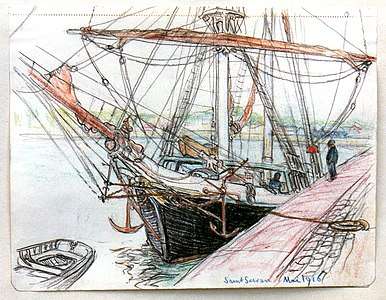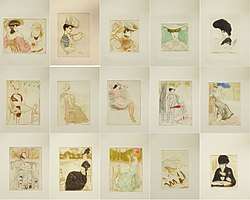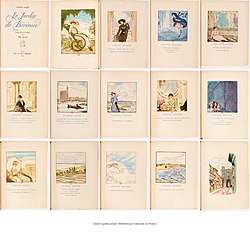Malo-Renault
Émile Auguste Renault, better known by his pseudonym Malo-Renault, was a French pastelist, color engraver and illustrator. He was born in Saint-Malo on October 5, 1870 and died in Le Havre on July 19, 1938.
Malo-Renault | |
|---|---|
.jpg) | |
| Born | Emile Auguste Renault October 5 1870 Saint-Malo |
| Died | July 19 1938 (aged 67–68) Le Havre |
| Nationality | Française |
| Education | Bachelor of Arts |
| Alma mater | École nationale supérieure des arts décoratifs |
| Known for | Pastel drawings, color prints, illustrated books, woodcuts |
| Style | Representational art, colorist |
| Movement | Art nouveau |
| Spouse(s) | Nori Malo-Renault |
| Patron(s) | Stéphane Pannemaker |
| Website | http://art-malo-renault.alwaysdata.net/ |
Biography
Since childhood he started drawing frequently. Auguste Lemoine (1848-1909), a drawing teacher at the college of Saint-Malo from 1883 to 1903 inspired him to draw from nature and in colour. Under the direction of Auguste Lemoine[1], Malo-Renault experimented with etchings.
After completing his Bachelor of Arts, Malo-Renault went on to study architecture in Paris as a Stéphane Pannemaker student at the École nationale supérieure des arts décoratifs.
It was only after his marriage in 1897 with Honorine Tian (1871-1953), known as Nori Malo-Renault, a student of etcher Géry-Bichard, that Malo-Renault began his engraving career with the support of his wife for the development of color prints, in particular in Le serpent noir by Paul Adam.
Between 1903 and 1928 he participated in many exhibitions at the Salon of the Société Nationale des Beaux-Arts, where he was a member from 1910. It is a representative of the art nouveau style with a Japanese influence.
Works
Color artwork
- Some prints in colors and pastels
%2C_Malo-Renault_(1870-1938).jpg) Menu des Cent Bibliophiles (1922) , Bois gravé en couleur
Menu des Cent Bibliophiles (1922) , Bois gravé en couleur Terre-neuvas (1916), Musée de Saint-Malo
Terre-neuvas (1916), Musée de Saint-Malo%2C_Malo-Renault_(1870-1938).jpg) Mère et Fille, Estampe en couleur (24x21 cm)
Mère et Fille, Estampe en couleur (24x21 cm)_EMR.jpg) Marché breton.
Marché breton._1912%2C_pointe_s%C3%A8che._Cabinet_des_Estampes%2C_Malo-Renault_(1870-1938).jpg) Cinq heures rue de la Paix, Pointe sèche en couleur (37x28 cm)
Cinq heures rue de la Paix, Pointe sèche en couleur (37x28 cm) Les Deux Pommes ou l’auberge, pointe sèche en couleur (1920), Musée de Pont-Aven.
Les Deux Pommes ou l’auberge, pointe sèche en couleur (1920), Musée de Pont-Aven.
Illustrated books
Litearature
- Jules Renard, Ragotte, etchings in black and white printed intaglio by Geny Gros, 28 × 19 cm, Paris, bookstore of the Collection des Dix, A. Ramagnol editions, 1909, 117 p.
- Malo-Renault, Quelques-unes, album, suite engraved in color of 15 Parisienne sketches, preface by Roger Marx, 41 × 29 cm, 1909.
- Paul Adam, Le Serpent noir, more than 80 etchings and drypoints in color, Les Cent bibliophiles, 29 × 21 cm, 1913, 335 p.
- Tristan Corbière, La Rapsode foraine et Le pardon de Sainte-Anne,[2] 12 woods enhanced with colors, 32 × 26 cm, Flory, 1920, 22 p.
- Maurice Barrès, Le Jardin de Bérénice,[3] 30 dry-points in color, 28 × 20 cm, Les Cent bibliophiles, 1922, 170 p.
- Émile Malo-Renault, Raquettes, text and 6 dry-points in color, 39 × 28 cm, L’Estampe nouvelle, 1923. Edition of 45 signed copies.
- François-René de Chateaubriand, René, 6 dry-points in color and headbands, 28 × 19 cm, prints printed by Porcabeuf, Paris, Dorbon, 1925, 101 p.
- Charles Perrault, Peau d'âne, La Belle au bois dormant, drawings by Malo-Renault, Larousse, 1923.
- Émile Souvestre,Les mille et une nuits de la Bretagne, (Le foyer Breton), illustrations by Malo Renault, (1929)
- Honoré de Balzac, Ursule Mirouët, Paris, collection « L'Adolescence catholique », 1928.
- Jean des Cognets, D'un vieux Monde, Drawings of Malo-Renault, printed monograph, O.L. Aubert (1932) Saint-Brieuc.
Some illustrations 1904 to 1928
- Drypoint prints, etchings, litho drawing by Malo-Renault:
 Malo-Renault, Quelques unes, 15 color drypoint (1904-1906)
Malo-Renault, Quelques unes, 15 color drypoint (1904-1906) Le jardin de Bérénice, M. Barrès, color drypoint (1922) Malo-Renault
Le jardin de Bérénice, M. Barrès, color drypoint (1922) Malo-Renault Le dessous des cartes d'une Partie de Whist, J.B. Aurevilly, dryprint prints Malo-Renault
Le dessous des cartes d'une Partie de Whist, J.B. Aurevilly, dryprint prints Malo-Renault%2C_ill._par_EMR.jpg) Contes de Bretagne de Paul Féval, dessin litho Malo-Renault. Ed. Les Arts et Livre (1928)
Contes de Bretagne de Paul Féval, dessin litho Malo-Renault. Ed. Les Arts et Livre (1928)
Youth literature
- Le Roi des Corsaires. Text and drawings by Malo-Renault (14 engravings), Paris, Larousse, 1919, << Les livres roses pour la jeunesse>>, n° 261 (200x130), 32 p.
- Chansons de France, reunited by Adolphe Gauwin, illustrations by Malo-Renault, Paris, 1923, 1925, 1926, 1928 ; Hachette, 1931 ; Hachette Jeunesse, 1993
Publications
- « Un artiste breton Daniel Mordant », Le Fureteur Breton, April–May 1907, second year, n° 10, p. 167-168.
- « Le peintre Auguste Lemoine », Annales de Société d'histoire et d'archéologique de l'arrondissement de Saint-Malo, 1910, p. 259-270.
- « Charles Le Goffic ». Le Nouvelliste de Bretagne, December 12, 1910.
- « Le Monotype», Art et décoration, February 1920, p. 49-56, 8 engravings.
- « Henri Rivière », Art et décoration, February. 1921, p. 43-51, 10 engravings
- « Les Merveilles du Livre italien », A.B.C magazine de l'art, June 1926, p. 177-181.
- « Sergent-Marceau et Emira Marceau graveurs », L' Amateur d' estampes, 1927
- « La technique d'Henri de Toulouse-Lautrec, graveur ». L'Amateur d'estampes, 6th year, no 3, May 1927, p. 83-87
- « La gravure sur bois: gravure au canif, gravure au burin, gravure en camaïeu, gravure en couleur », Le Dessin, revue d'art, d' éducation et d'enseignement, October 1930, p. 369-372 ; et novembre 1930, p. 429-432.
- « La gravure en taille-douce. Le pointillé, la manière noire ou mezzotint, la pointe sèche », Le Dessin, Avril 1931, n° 12, p. 744-749.
- « La gravure en taille-douce (suite). L'eau-forte, l' aquatinte et le vernis mou) », Le Dessin, May 1931, p 46-52..
| Wikimedia Commons has media related to: |